The Shaw Group Inc. is working to pry loose and draw in a large portion of the nation’s dredging fleet―potentially seven cutterheads, five large hoppers and a dozen scows―for the emergency delivery of roughly 45 miles of permitted projects (of 128 miles sought) of barrier berm on the Louisiana coast... that state officials hope will protect inland marshes from the BP Deepwater Horizon oil spill. The problem is, a lot of the equipment already is occupied elsewhere.
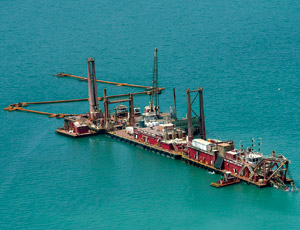
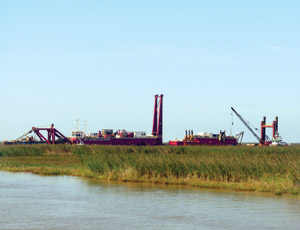
“Much of the equipment is under contract to other entities, mostly the Corps of Engineers,” says Charlie Hess, a project manager with the Baton Rouge, La.-based contractor.
“Most dredges we are talking about are working navigation projects,” says Chris Accardo, chief of operations division for the U.S. Army Corps of Engineers New Orleans District. “We understand the urgency for the berm construction, but at the same time we don’t want to throw navigation interests under the bus. We’re trying to balance the navigation mission with berm construction.”
By June 14, Shaw had two dredges signed up to help build the $360-million project to reinforce barrier islands from the Chandeleur Islands on the east side of the mouth of the Mississippi River Delta to the Scofield Island on the west. The state’s goal is to raise and connect segmented and low-rise islands to create a 6-ft-plus elevation bulwark to prevent floating oil from migrating on the tide into the marshes.
The California, a cutterhead dredge belonging to Great Lakes Dredge & Dock Co., Oak Brook, Ill., already was operating near the site on an unrelated project for the Corps. It is now preforming pipe-laying work in the northernmost reach of the berming project area; it has switched to the berming operation. Shaw also has engaged the Stuyvesant, a hopper dredge owned by Stuyvesant Dredging Inc., New Orleans, to begin work immediately.
The Stuyvesant was not under contract, so putting it to work was relatively straightforward, but Great Lakes had to obtain a no-cost extension on its pipe-laying contract with the Corps to get released for the berm work. The Corps decided the pipe laying was not as critical as the berm building, Hess says.
However, Shaw is having more difficulty obtaining a contract release on two other hopper dredges, the Bayport and the Newport. Their owner, Seattle-based Manson Construction Co., had both already under contract for Mississippi River dredging.
For a dredge to be moved from a Corps project to the berm barrier, the dredging contractor that owns the equipment—neither Shaw nor the state—must request a release from the contracting district, explains Bruce Terrell, chief of the Corps’ New Orleans District (NOD) construction division.
“We are entertaining requests for no-cost extensions under suspension-of-work clauses in the contracts,” Terrell says. “Contractually, we can agree to a modification of the contract that temporarily suspends work on that contract at no cost to the government for some estimated time period.”
The government doesn’t want to release the dredges indefinitely, Terrell adds, so the extensions must include a time estimate. “We make a determination on a project-by-project basis as to whether or not that can happen,” Accardo says. Suspending operations can have negative consequences. Taking a dredge off channel maintenance, for instance, can create problems for navigation.
“If we were to take all of the hopper dredges out of Southwest Pass [at the mouth of the Mississippi],” Accardo says, “that would cause the draft level to be bumped up. That request would have to go higher up the chain of command, and both the state and federal government would have to look at it to determine what’s in the best interest of the public.”
The Corps is expediting requests as quickly as possible, says Ken Holder, director of public affairs, NOD. “Within three hours after we got the request to release the California, we had it released.”
However, many competing interests are weighing in on the significance of missions and priorities.
If dredging is reduced at Southwest Pass, which routinely shoals, it could affect nationwide commerce, says Capt. Michael R. Lorino Jr., president of the Associated Branch Pilots (bar pilots) for the Port of New Orleans. “If you close the pass, it would not be best for the state and country,” Lorino says.
Bar pilots are skilled in maneuvering ocean-going vessels through the mouth of the river, which is riddled with sandbars and low-draft areas, but Lorino says if dredging is cut back enough to change draft depth, certain size vessels, like big oil tankers, would not be able to pass at all.
“They are moving some dredges around, but I have been assured by the Corps, the state and everyone else involved that Southwest Pass will be maintained to proper dimensions,” Lorino says.
There is some concern within the dredging industry that the urgency of the berm barrier project will pave the way for a Jones Act waiver, which would drop a legal bar that prevents foreign vessels from taking contracts to perform work in U.S. waters.
Jones Act waivers are “very infrequent,” says a spokesperson for the Maritime Cabotage Task Force, which is dedicated to promoting the economic benefits of the Jones Act.
The biggest Jones Act waiver was in 2005, after Hurricanes Katrina and Rita.
To obtain a waiver, a request would have to be made by “an individual or secretary of a department” to the U.S. Dept. of Homeland Security/U.S. Customs and Border Protection, the MCTF spokesperson explains. DHS/Customs would consult with the U.S. Maritime Administration (MARAD) regarding the availability of vessels.

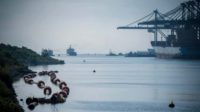
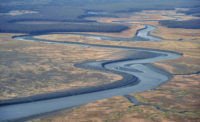
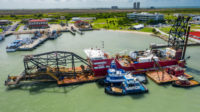

Post a comment to this article
Report Abusive Comment